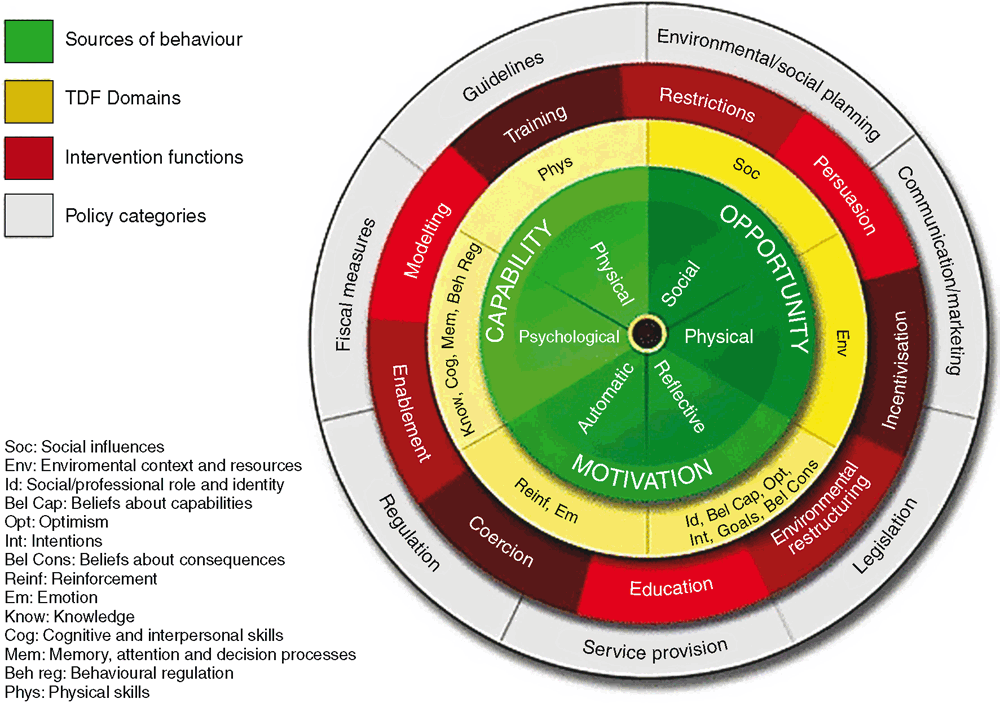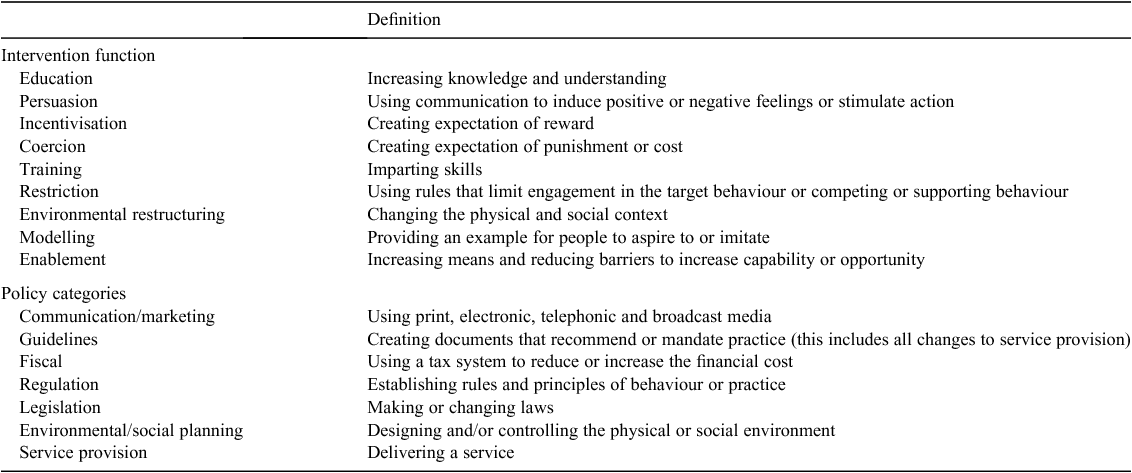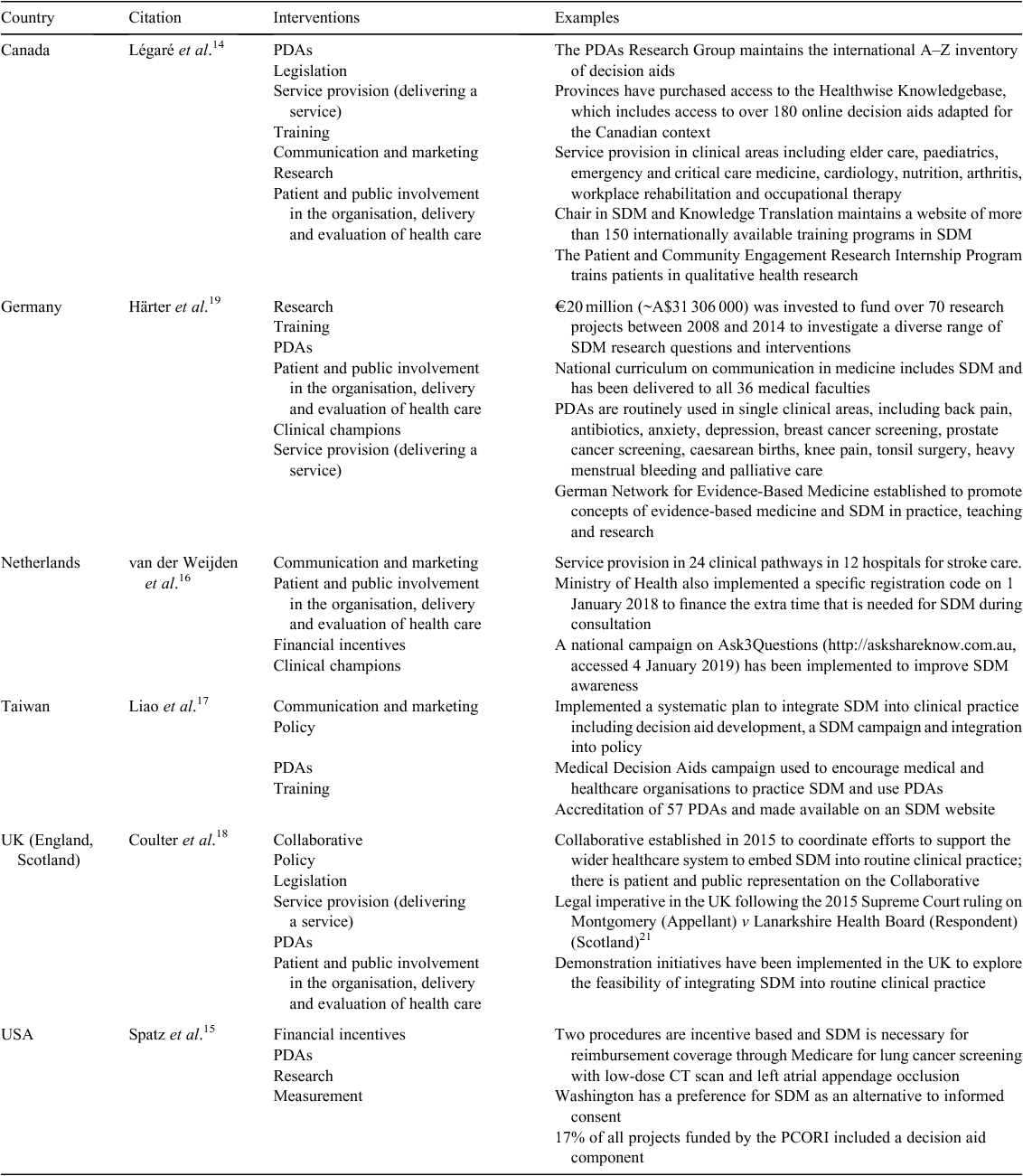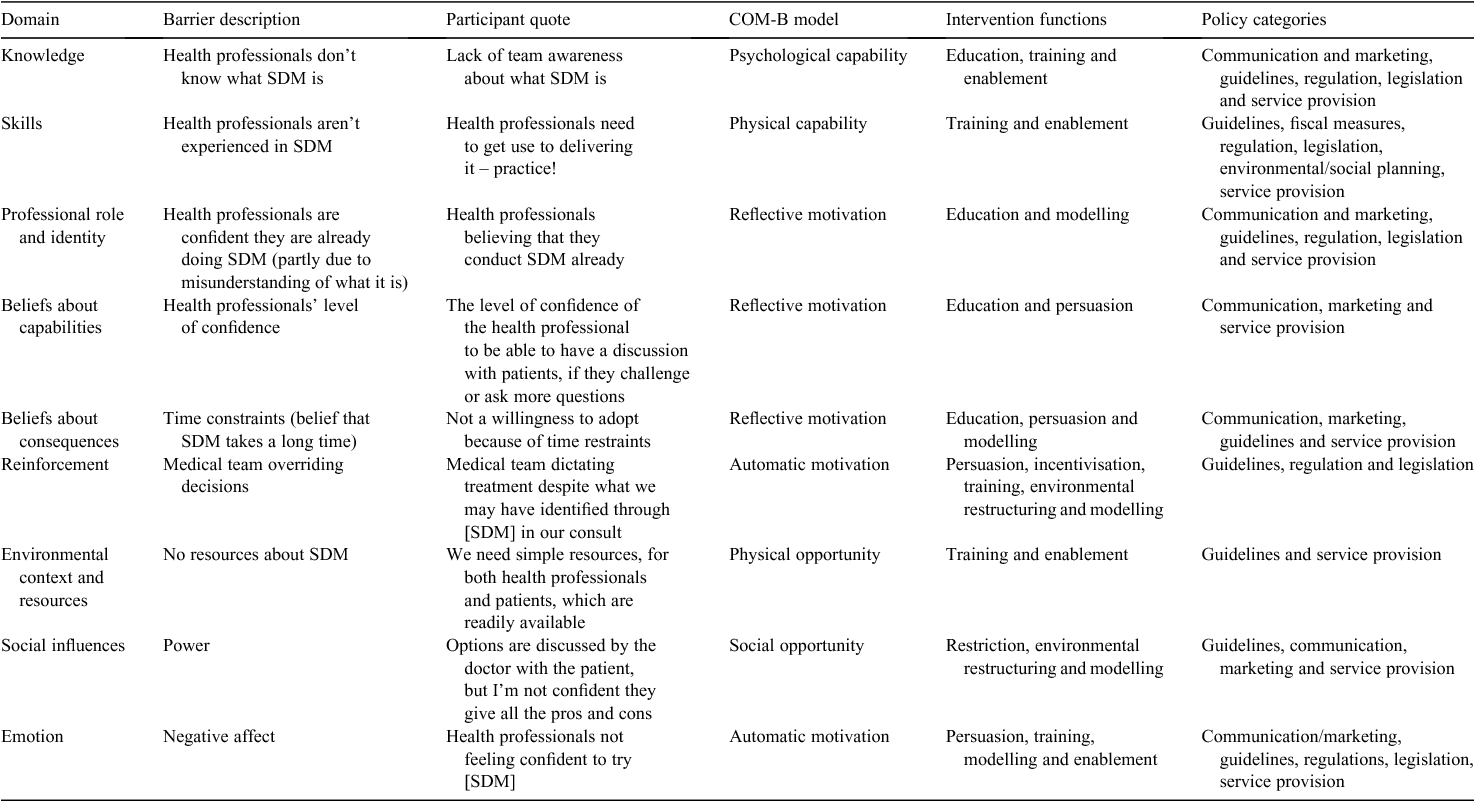Shared decision making implementation: a case study analysis to increase uptake in New South Wales
Tara Dimopoulos-Bick A D , Regina Osten A , Chris Shipway A , Lyndal Trevena B and Tammy Hoffmann CA NSW Agency for Clinical Innovation, Albert Avenue, Chatswood, NSW 2067, Australia. Email: regina.osten@health.nsw.gov.au; chris.shipway@health.nsw.gov.au
B University of Sydney, Sydney School of Public Health, Camperdown, NSW 2006, Australia. Email: lyndal.trevena@sydney.edu.au
C Bond University Faculty of Health Sciences and Medicine, University Drive, Robina, Qld 4226, Australia. Email: thoffman@bond.edu.au
D Corresponding author. Email: tara.dimopoulosbick@health.nsw.gov.au
Australian Health Review 43(5) 492-499 https://doi.org/10.1071/AH18138
Submitted: 4 July 2018 Accepted: 16 October 2018 Published: 31 January 2019
Journal Compilation © AHHA 2019 Open Access CC BY-NC-ND
Abstract
The aim of this study was to identify potential implementation interventions to increase the uptake of shared decision making (SDM) in clinical practice in New South Wales (NSW) Health. The Agency for Clinical Innovation hosted a full-day SDM masterclass in May 2017 and 53 attendees completed a survey to identify barriers to implementing SDM. The Theoretical Domains Framework, COM-B (‘capability’, ‘opportunity’, motivation’ and ‘behaviour’) Model and Behaviour Change Wheel were used to conduct a theoretical analysis of the barriers and identify potential interventions to increase the uptake of SDM. This was supplemented by a purposive review of articles about current international efforts to facilitate SDM. From the theoretical analysis, 9 of the 14 theoretical domains were considered relevant to implementing SDM in the NSW Health context. Multi-faceted interventions including education, training, enablement, modelling, incentivisation, persuasion and environmental restructuring were identified as potential ways to increase SDM. The review of international articles identified communication and marketing, patient and public involvement, research, training, legislation, patient decision aids, service provision, clinical champions, financial incentives and policy as interventions being used to increase the uptake of SDM internationally. Based on current perceptions about barriers for SDM implementation in NSW Health, initial efforts should focus on workforce skills development, motivation, communication and marketing, service provision and creating receptive work environments. Investments into facilitating SDM will require an ongoing commitment to enhancing patient experience, evidence translation and reducing unwarranted variations in care.
What is known about the topic? Shared decision making is considered an important strategy for reducing unwarranted variation in health care and promoting person-centred care. Despite a growing evidence base, uptake in Australia has been slow.
What does this paper add? A description of the theoretical methods and results used to identify potential implementation interventions to increase the uptake of shared decision making clinical practice in New South Wales Health, Australia.
What are the implications for practitioners? Learnings from this present case study may be relevant to other organisations wanting to support a culture of shared decision making and meet the National Safety and Quality Healthcare Standards in Australia.
Introduction
Shared decision making (SDM) is a process of involving patients in making informed and preference-based decisions about their care and treatment.1 Patient decision aids (PDAs) have been the most frequently evaluated intervention for facilitating SDM. PDAs present evidence-based information about options, the benefits and harms of each and can be used to guide patients through the decision-making process.2
A 2017 Cochrane review of the effects of PDAs for health treatment and screening decisions included 105 randomised controlled trials that compared PDAs to usual care.3 Patients who were provided with PDAs had increased knowledge and were better informed, had more accurate risk perceptions and were more involved in the decision-making process than those who were not. There was no consistent effect on cost, adherence or health outcomes.3
It is expected that the demand for SDM will grow exponentially in Australia, particularly given the explicit focus on sharing decisions and planning outlined in the second edition of the National Safety and Quality Health Service Standards.4 Similarly, the Australian Commission on Safety and Quality in Health Care’s (ACSQHC) Australian Atlas of Healthcare Variation has emphasised that SDM is an important strategy for reducing unwarranted variation in health care and promoting person-centred care.5 Although there is some overlap between SDM and informed consent, the intent, scope and practice of each is distinctively different, and SDM applies to a wider range of decisions.6
Despite the emerging evidence base about SDM, its uptake in Australia has been slow. Barriers to using SDM in Australia include a lack of coordinated national effort, policy, advocacy, research funding, training, resources and implementation.7
The Agency for Clinical Innovation (ACI) is an organisation within NSW Health that partners with patients and health professionals to design and promote better health care for New South Wales (NSW). ACI supports local health districts and speciality health networks by providing specialist advice on healthcare innovation and implementation support, as well as through initiatives including clinical guidelines and models of care.8 The context for the present case study is NSW Health, but the learnings may also be relevant to other health organisations and settings.
There is limited available evidence of SDM implementation in NSW Health. The Bureau of Health Information (BHI) has routinely collected broader patient-centred care measures, including whether the patient was involved in decisions about treatment and the provision of information for patients and their families. However, these measures do not encapsulate all elements of the SDM process, including the presentation of alternative options, their benefits and harms and the elicitation of patient values and preferences for care.9
To facilitate sustainable implementation of SDM in NSW Health, not only do we need to measure and better understand our performance, but we also need to understand and address the barriers to its use in a systematic way. Learnings from the present case study can be used to consider where investments can be made to progress SDM as part of an ongoing commitment to enhancing patient experience, evidence translation and reducing unwarranted variations in health care.
Objective
The aim of this case study is to describe the methods and results used to identify potential implementation interventions to increase the uptake of SDM in clinical practice in NSW Health.
Methods
Two methods were used to identify potential interventions to increase the uptake of SDM. First, a theoretical analysis was conducted of barriers identified by local NSW health professionals and patients. Second, interventions being used to facilitate SDM internationally were identified through a rapid and purposive review of articles published in the 2017 special edition of the Zeitschriftfür Evidenz, Fortbildung und Qualität im Gesundheitswesen (Journal of Evidence and Quality in Health Care): International Accomplishments in Shared Decision Making.10
To identify local barriers to implementing SDM, a convenience sample of participants who attended a 1-day SDM masterclass held by ACI in Sydney in May 2017 was surveyed. The theoretical domains framework (TDF), COM-B (‘capability’, ‘opportunity’, motivation’ and ‘behaviour’) model and behaviour change wheel (BCW) were used to conduct a theoretical analysis of the barriers and to identify potential intervention functions and policy categories for the implementation of SDM in NSW Health.11–13
The TDF, COM-B model and BCW form an evidence-based integrated system for identifying interventions aimed at influencing behaviour and improving the uptake of evidence into practice. The TDF has 14 domains that contain factors likely to influence the behaviour of health professionals. The domains can be linked to a component within the BCW to demonstrate the connection between capability, opportunity, motivation and changes in behaviour. The links can be further mapped to the intervention functions and policy categories that are considered more likely to influence the behaviour of health professionals and improve the uptake of SDM (Fig. 1).11–13

|
Participant responses were classified according to the domains within the TDF and sources of behaviour using the COM-B model by two authors (TD-B, RO). Coded statements within the domains were used to generate barrier descriptions that represented the common themes that were perceived to influence the uptake of SDM. The classifications were reviewed and refined by four authors (TD-B, RO, TH, LT) until consensus was reached.
The BCW was then used to identify intervention functions and policy categories that could be effective in addressing the barriers. The appropriateness of the interventions and policy categories was evaluated by the authors (TD-B, RO), a local NSW health professional and a patient in a two-stage process using the APEASE criteria (Acceptability, Practicality, Effectiveness/cost-effectiveness, Affordability, Safety/side effects and Equity).11,12 The four reviewers independently applied the criteria and then engaged in an in-depth discussion to review the results and any discrepancies.
To identify implementation interventions that are being used to facilitate SDM internationally, a rapid and purposive review of a 2017 special edition of SDM implementation articles10 was conducted. This edition is the premier source of current evidence about interventions for facilitating SDM internationally, with contributions from 22 countries, and is the only contemporary collection of articles reporting on SDM implementation in a range of countries. Contributing authors to this edition were required to describe interventions being used to facilitate SDM at the macro-, meso- and microlevels.10 The analysis for the present case study included a review of all articles by one author (TD-B), with extraction and categorising of implementation interventions identified.
Results
Barriers analysis
Of the 83 participants who attended the SDM masterclass, 53 (64%) completed the survey. Participants included allied health (n = 19), consumers (n = 5), doctors and specialists (n = 3), managers (n = 11), nurses (n = 6), project and policy officers (n = 3) and researchers (n = 4).
Barriers were identified across nine of the 14 domains of the TDF, including knowledge, skills, professional role and identity, beliefs about capabilities, beliefs about consequences, reinforcement, environmental context and resources, social influences and emotion. Some barriers were more frequently identified than others, including knowledge, skills, professional role and identify, belief about capabilities, environmental context and resources. Domains not identified were optimism, intentions, behavioural regulation, goals, memory or attention and decision processes (Table 1).
The main barriers identified were coded to the domain of environmental context and resources. Participants perceived time constraints, competing priorities and limited access to resources, including information about SDM, decision aids and high-quality synthesised evidence, as barriers:
We need simple resources, for both clinicians and patients, which are readily available.
Organisational culture, including a lack of implementation intention and leadership to support the systematic use of SDM, was also reported as a barrier:
We need engagement from senior managers to endorse this approach.
Several barriers, including expert culture, influence among health professionals and paternalistic practices, were coded to professional role and identity:
The medical model dominates the relationship between the patient and the health professional.
Fear and the risk of negative affect were identified as emotion-related barriers. Participants were concerned that health professionals may not have the confidence or be supported to use SDM in their clinical practice:
Staff not feeling supported or having the confidence to try…
Beliefs about capabilities, including perceived competence, and patients not having the capacity to engage in SDM were reported as barriers:
Health professionals believing that they conduct shared decision making already is a barrier.
A high number of barriers were also coded to the domains of knowledge and skills:
Shared decision making is a skill that needs to be learnt by both patients and health professionals.
Participants reported that a lack of awareness of what SDM is was a barrier for patients and health professionals:
There is a lack of community awareness and education about SDM.
Following the application of the TDF, COM-B model and BCW, the following interventions were considered appropriate for supporting the implementation of SDM: education, training, enablement, modelling, incentivisation, persuasion and environmental restructuring. Policy categories identified as potential enablers for the interventions to occur were communication and marketing, guidelines, service provision and legislation (Tables 2, 3).

|

|
International review
The articles included in the review were from the 22 countries: Africa, Argentina, Australia, Brazil, Canada, Chile, China, Denmark, France, Germany, Iran, Israel, Italy, Malaysia, Netherlands, Norway, Peru, Spain, Switzerland, Taiwan, the UK and the US.10
Although significant progress has been made, there remains a lack of systematic implementation and coordination of SDM internationally.10 Countries that have systematically approached the implementation of SDM include Canada, Germany, the Netherlands, Taiwan, UK and the US. In these countries, SDM is being established at a policy level, and system-wide implementation strategies with leadership and financial support have been developed.14–20
Interventions tested and implemented in these countries include communication and marketing, patient and public involvement, research, training, legislation, access to PDAs, service provision, clinical champions, financial incentives and policy14–19 (Table 4).

|
Discussion
This case study examined the barriers to implementing SDM, using a theory-informed systematic approach to identify interventions that could be used to increase its use in NSW Health and a rapid and purposive review of contemporary articles on SDM implementation interventions internationally.
Although significant efforts have been made to facilitate SDM, it is still far from routine clinical practice internationally or in Australia. The perceived barriers identified for NSW Health are similar to those encountered internationally.7,14–20
For NSW Health, the high number of participant responses coded to the theoretical domain ‘environmental context and resources’ suggests the importance of attending to organisational culture and ensuring resources are available to support the use of SDM in clinical practice.
In the UK, the National Institute for Health and Care Excellence (NICE) collaborative is a group of organisations and individuals committed to embedding SDM across UK health systems.18,22 A similar collaborative model could be assessed for feasibility in NSW Health, or collectively with other states and territories to support a culture of SDM in Australia.
Results from the theoretical analysis showed that poor access to PDAs or resources about SDM were barriers to implementation. The Ottawa Hospital Research Institute in Canada leads and updates the Cochrane review on decision aids and maintains the A–Z international inventory on decision aids.3,23 Active dissemination strategies could be used to increase awareness of the inventory and encourage health professionals to use relevant PDAs in their practice. A cost–benefit analysis could also be conducted to examine the feasibility of purchasing a library of decision aids from a third party provider or establishing a state or national portal of PDAs. A review process would also need to be established to ensure the tools reflected current evidence and were relevant to the Australian context. Many countries have highlighted the difficulties in maintaining the currency of PDAs.15,18,20
Greater investment in education, training and modelling for health professionals could address knowledge- and skill-related barriers. Common myths that may prevent health professionals from using SDM in their practice include misconceptions that it will increase consultation time and that patients will feel abandoned throughout the process.7 The ACSQHC has developed tools and resources to support SDM, including freely available short videos to challenge common myths about SDM and explain the role of PDAs, and an eLearning module to support health professionals to enhance their SDM knowledge and skills.24
If investments are made in developing and delivering new training and education programs in NSW Health, it is recommended that the content is tailored to specific disciplines or clinical settings and evaluated to determine effectiveness.25,26
Structured opportunities to apply new knowledge and skills in service delivery could further increase the uptake of SDM in practice. The UK has invested in several demonstration initiatives to explore the feasibility of integrating SDM into routine clinical practice. Learnings from the Making Good Decisions in Collaboration (MAGIC) showed the effectiveness of action learning strategies in ensuring health professionals had the time and space to practice SDM skills and get feedback.27 This could be mirrored in NSW and more broadly by testing theory-informed and evidence-based interventions for SDM in demonstration sites in different clinical settings. Evaluation of the demonstration sites could include patient-centred care measures and the observation and analysis of available and needed resources to facilitate SDM.
Embedding SDM in national and state practice standards and clinical guidelines could be effective in facilitating SDM and building credibility with health professionals. NICE has produced several evidence-based guidelines highlighting the value, use and effects of SDM in clinical practice.18,20
Stronger leadership from health professionals, executive, advocacy organisations and speciality societies would help address professional role and identity barriers.20 In the Netherlands, the Ministry of Health has established a culture that supports and enables SDM through the provision of registration codes to finance extra time needed for an SDM process.16,20
Active dissemination strategies, including communication and marketing campaigns, could be effective in addressing professional role and identity and knowledge-, skill- and emotion-related barriers. In the Netherlands, a national campaign coined Betere zorg begint met een goed gesprek, which translates to ‘better care starts with a good conversation’, has been effective in increasing awareness of SDM.16,20 SDM is also being promoted in the Choosing Wisely Campaign by the UK’s Academy of Medical Royal Colleges.18,20 The Choosing Wisely Campaign is an international initiative designed to help health professionals and patients engage in conversations about improving the quality of health care by eliminating unnecessary tests, treatments and procedures.28
Conclusion
This case study has discussed several pertinent considerations for the implementation of SDM in NSW Health and the learnings may be relevant to other organisations wanting to support a culture of SDM and meet the new National Safety and Quality Healthcare Standards in Australia. Investments into SDM for all health organisations should be considered as an ongoing commitment to enhancing patient experience, evidence translation and reducing unwarranted variations in care.
Competing interests
None declared.
Acknowledgements
This study was funded through a Sax Institute 2017 Hospital Alliance for Research Collaborative (HARC) scholarship for Tara Dimopoulos-Bick.
References
[1] Elwyn G. Shared decision-making in health care. 3rd edn. Oxford: Oxford University Press; 2016.[2] Witteman HO, Dansokho SC, Colquhoun H, Coulter A, Dugas M, Fagerlin A, Giguere AM, Glouberman S, Haslett L, Hoffman A, Ivers N, Légaré F, Légaré J, Levin C, Lopez K, Montori VM, Provencher T, Renaud JS, Sparling K, Stacey D, Vaisson G, Volk RJ, Witteman W. User-centered design and the development of patient decision aids: protocol for a systematic review. Syst Rev 2015; 4 11
| User-centered design and the development of patient decision aids: protocol for a systematic review.Crossref | GoogleScholarGoogle Scholar | 25623074PubMed |
[3] Stacey D, Légaré F, Lewis K, Barry MJ, Bennett CL, Eden KB, Holmes-Rovner M, Llewellyn-Thomas H, Lyddiatt A, Thomson R, Trevena L. Decision aids for people facing health treatment or screening decisions. Cochrane Database Syst Rev 2017; 4 CD001431
| Decision aids for people facing health treatment or screening decisions.Crossref | GoogleScholarGoogle Scholar | 28402085PubMed |
[4] Australian Commission on Safety and Quality in Health Care. National safety and quality health service standards. Second edition. 2018. Available at: https://www.safetyandquality.gov.au/our-work/assessment-to-the-nsqhs-standards/nsqhs-standards-second-edition [verified 26 June 2018].
[5] Australian Commission on Safety and Quality in Health Care. The second Australian atlas of healthcare variation 2017. 2018. Available at: https://www.safetyandquality.gov.au/atlas/atlas-2017 [verified 26 June 2018].
[6] Lindor RA, Kunneman M, Hanzel M, Schuur JD, Montori VM, Sadosty AT. Liability and informed consent in the context of shared decision making. Acad Emerg Med 2016; 23 1428–33.
| Liability and informed consent in the context of shared decision making.Crossref | GoogleScholarGoogle Scholar | 27607573PubMed |
[7] Hoffmann TC, Légaré F, Simmons MB, McNamara K, McCaffery K, Trevena LJ, Hudson B, Glasziou PP, Del Mar CB. Shared decision making: what do clinicians need to know and why should they bother? Med J Aust 2014; 201 35–9.
| Shared decision making: what do clinicians need to know and why should they bother?Crossref | GoogleScholarGoogle Scholar | 24999896PubMed |
[8] NSW Government. Agency for clinical innovation. 2018. Available at: https://www.aci.health.nsw.gov.au/about-aci [verified 5 August 2018].
[9] Bureau of Health Information. Healthcare observer. 2018. Available at: http://www.bhi.nsw.gov.au/nsw_patient_survey_program/adult_admitted_patient_survey [verified 5 June 2018].
[10] Härter M, Moumjid N, Cornuz J, Elwyn G, van der Weijden T. International accomplishments in shared decision making. Z Evid Fortbild Qual Gesundhwes 2017; 123–124 1–108.
| International accomplishments in shared decision making.Crossref | GoogleScholarGoogle Scholar | 28546053PubMed |
[11] Michie S, van Stralen M, West R. The behaviour change wheel: a new method for characterising and designing behaviour change interventions. Implement Sci 2011; 6 42
| The behaviour change wheel: a new method for characterising and designing behaviour change interventions.Crossref | GoogleScholarGoogle Scholar | 21513547PubMed |
[12] Michie S, Atkins L, West R. The behaviour change wheel: a guide to designing interventions. 2nd ed. Sutton: Silverback Publishing; 2014.
[13] Cane J, O’Connor D, Michie S. Validation of the theoretical domains framework for use in behaviour change and implementation research. Implement Sci 2012; 7 37
| Validation of the theoretical domains framework for use in behaviour change and implementation research.Crossref | GoogleScholarGoogle Scholar | 22530986PubMed |
[14] Légaré F, Stacey D, Forest PG, Coutu MF, Archambault P, Boland L, Witteman HO, LeBlanc A, Lewis KB, Giguere AMC. Milestones, barriers and beacons: shared decision making in Canada inches ahead. Z Evid Fortbild Qual Gesundhwes 2017; 123–124 23–7.
| Milestones, barriers and beacons: shared decision making in Canada inches ahead.Crossref | GoogleScholarGoogle Scholar | 28532628PubMed |
[15] Spatz ES, Elwyn G, Moulton BW, Volk RJ, Frosch DL. Shared decision making as part of value based care: new U.S. policies challenge our readiness. Z Evid Fortbild Qual Gesundhwes 2017; 123–124 104–8.
| Shared decision making as part of value based care: new U.S. policies challenge our readiness.Crossref | GoogleScholarGoogle Scholar | 28532630PubMed |
[16] van der Weijden T, Post H, Brand P, van Veenendaal H, Drenthen T, van Mierlo L, Stalmeier P, Damman OC, Stiggelbout A. Shared decision making, a buzz-word in the Netherlands, the pace quickens towards nationwide implementation... Z Evid Fortbild Qual Gesundhwes 2017; 123–124 69–74.
| Shared decision making, a buzz-word in the Netherlands, the pace quickens towards nationwide implementation...Crossref | GoogleScholarGoogle Scholar | 28529122PubMed |
[17] Liao H-H, Liang H-W, Chen H-C, Chang C-I, Wang P-C, Shih C-L. Shared decision making in Taiwan. Z Evid Fortbild Qual Gesundhwes 2017; 123–124 95–8.
| Shared decision making in Taiwan.Crossref | GoogleScholarGoogle Scholar | 28526230PubMed |
[18] Coulter A, Edwards A, Entwistle V, Kramer G, Nye A, Thomson R, Walker E. Shared decision making in the UK: moving towards wider uptake. Z Evid Fortbild Qual Gesundhwes 2017; 123–124 99–103.
| Shared decision making in the UK: moving towards wider uptake.Crossref | GoogleScholarGoogle Scholar | 28532629PubMed |
[19] Härter M, Dirmaier J, Scholl I, Donner-Banzhoff N, Dierks M, Eich W, Müller H, Klemperer D, Koch K, Bieber C. The long way of implementing patient-centered care and shared decision making in Germany. Z Evid Fortbild Qual Gesundhwes 2017; 123–124 46–51.
| The long way of implementing patient-centered care and shared decision making in Germany.Crossref | GoogleScholarGoogle Scholar | 28546055PubMed |
[20] Coulter A. National strategies for implementing shared decision making. Gutersloch: Bertelsmann Stiftung; 2018. Available at: https://www.bertelsmann-stiftung.de/en/publications/publication/did/national-strategies-for-implementing-shared-decision-making-engl/ [verified 10 October 2018].
[21] Montgomery (Appellant) v Lanarkshire Health Board (Respondent) (Scotland). 2015. Available at: https://www.supremecourt.uk/decided-cases/docs/UKSC_2013_0136_Judgment.pdf [verified 29 November 2018].
[22] National Institute for Health and Care Excellence. Shared decision making. 2018. Available at: https://www.nice.org.uk/about/what-we-do/our-programmes/nice-guidance/nice-guidelines/shared-decision-making [verified 4 September 2018].
[23] Ottawa Hospital Research Institute. Patient Decision Aids. 2018. Available at: https://decisionaid.ohri.ca/azinvent.php [verified 1 June 2018].
[24] Australian Commission on Safety and Quality in Health Care. Shared decision making. 2018. Available at: https://www.safetyandquality.gov.au/our-work/shared-decision-making [verified 26 June 2018].
[25] Université Laval. Canada Research Chair in Shared Decision Making and Knowledge Translation. Inventory of shared decision making programs for healthcare professionals. 2018. Available at: http://decision.chaire.fmed.ulaval.ca/inventaire-formation-en [verified 26 June 2018].
[26] Diouf NT, Menear M, Robitaille H, Painchaud Guérard G, Légaré F. Training health professionals in shared decision making: update of an international environmental scan. Patient Educ Couns 2016; 99 1753–8.
| Training health professionals in shared decision making: update of an international environmental scan.Crossref | GoogleScholarGoogle Scholar | 27353259PubMed |
[27] Joseph-Williams N, Lloyd A, Edwards A, Stobbart L, Tomson D, Macphail S, Dodd C, Brain K, Elwyn G, Thomson R. Implementing shared decision making in the NHS: lessons from the MAGIC programme. BMJ 2017; 357 j1744
| Implementing shared decision making in the NHS: lessons from the MAGIC programme.Crossref | GoogleScholarGoogle Scholar | 28420639PubMed |
[28] ABIM Foundation. Choosing wisely. 2018. Available at: http://www.choosingwisely.org/wp-content/uploads/2017/10/Choosing-Wisely-at-Five.pdf [verified 4 September 2018].



